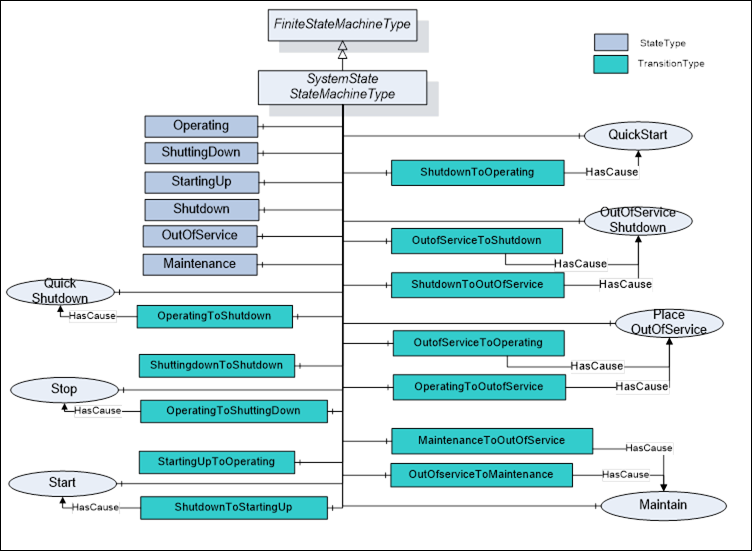Errata exists for this version of the document.
The SystemStateStateMachineType includes a hierarchy of sub-states. It supports multiple transitions between Operating, StartingUp, ShuttingDown, Shutdown, OutOfService and Maintenance.
The state machine is illustrated in Figure F.2 and formally defined in Table 51.

Figure F.2 - SystemStateStateMachineType Model
Table F.1 – SystemStateStateMachineType definition
|
Attribute |
Value |
||||||
|
BrowseName |
SystemStateStateMachineType |
||||||
|
IsAbstract |
False |
||||||
|
References |
Node Class |
BrowseName |
DataType |
TypeDefinition |
Modelling Rule |
||
|
Subtype of the FiniteStateMachineType defined in OPC 10000-5 |
|
||||||
|
|
|
|
|
|
|
||
|
HasComponent |
Object |
Operating |
|
StateType |
|
||
|
HasComponent |
Object |
ShuttingDown |
|
StateType |
|
||
|
HasComponent |
Object |
StartingUp |
|
StateType |
|
||
|
HasComponent |
Object |
Shutdown |
|
StateType |
|
||
|
HasComponent |
Object |
OutOfService |
|
StateType |
|
||
|
HasComponent |
Object |
Maintenance |
|
StateType |
|
||
|
|
|
|
|
|
|
||
|
HasComponent |
Object |
ShutdownToOperating |
|
TransitionType |
|
||
|
HasComponent |
Object |
OperatingToShutdown |
|
TransitionType |
|
||
|
HasComponent |
Object |
ShuttingdownToShutdown |
|
TransitionType |
|
||
|
HasComponent |
Object |
OperatingToShuttingdown |
|
TransitionType |
|
||
|
HasComponent |
Object |
StartingUpToOperating |
|
TransitionType |
|
||
|
HasComponent |
Object |
ShutdownToStartingUp |
|
TransitionType |
|
||
|
HasComponent |
Object |
OutofServiceToShutdown |
|
TransitionType |
|
||
|
HasComponent |
Object |
ShutdownToOutOfService |
|
TransitionType |
|
||
|
HasComponent |
Object |
OutofServiceToOperating |
|
TransitionType |
|
||
|
HasComponent |
Object |
OperatingToOutofService |
|
TransitionType |
|
||
|
HasComponent |
Object |
MaintenanceToOutOfService |
|
TransitionType |
|
||
|
HasComponent |
Object |
OutOfServiceToMaintenance |
|
TransitionType |
|
||
|
|
|
|
|
|
|
||
|
HasComponent |
Method |
Start |
Defined in Clause XXX |
Optional |
|||
|
HasComponent |
Method |
Maintain |
Defined in Clause XXX |
Optional |
|||
|
HasComponent |
Method |
Stop |
Defined in Clause XXX |
Optional |
|||
|
HasComponent |
Method |
PlaceOutOfservice |
Defined in Clause XXX |
Optional |
|||
|
HasComponent |
Method |
QuickShutdown |
Defined in Clause XXX |
Optional |
|||
|
HasComponent |
Method |
QuickStart |
Defined in Clause XXX |
Optional |
|||
|
HasComponent |
Method |
OutOfServiceShutdown |
Defined in Clause XXX |
Optional |
|||
|
|
|
|
|
|
|||
The actual selection of States and Transitions would depend on the deployment of the StateMachine. If the StateMachine were being applied to a tank or other part of a process it might have a different set of States then if it was applied to a meter or instrument. The meter may only have Operating, OutOfService and Maintenance, while the tank may have all of the described States and Transitions.
The StateMachine supports six possible states including: Operating, ShuttingDown, StartingUp, Shutdown, OutOfService, Maintenance. It supports 12 possible Transitions and 7 possible Methods.
Table F.2 - SystemStateStateMachineType transitions
|
BrowseName |
References |
BrowseName |
TypeDefinition |
|
|
|||
|
Transitions |
|||
|
ShutdownToOperating |
FromState |
Shutdown |
StateType |
|
|
ToState |
Operating |
StateType |
|
|
HasCause |
QuickStart |
|
|
OperatingToShutdown |
FromState |
Operating |
StateType |
|
|
ToState |
Shutdown |
StateType |
|
|
HasCause |
QuickShutdown |
|
|
ShuttingdownToShutdown |
FromState |
ShuttingDown |
StateType |
|
|
ToState |
Shutdown |
StateType |
|
OperatingToShuttingdown |
FromState |
Operating |
StateType |
|
|
ToState |
ShuttingDown |
StateType |
|
|
HasCause |
Stop |
|
|
StartingUpToOperating |
FromState |
StartingUp |
StateType |
|
|
ToState |
Operating |
StateType |
|
ShutdownToStartingUp |
FromState |
Shutdown |
StateType |
|
|
ToState |
StartingUp |
StateType |
|
|
HasCause |
Start |
|
|
OutofServiceToShutdown |
FromState |
OutOfService |
StateType |
|
|
ToState |
Shutdown |
StateType |
|
|
HasCause |
OutOfServiceShutdown |
|
|
ShutdownToOutOfService |
FromState |
Shutdown |
StateType |
|
|
ToState |
OutOfService |
StateType |
|
|
HasCause |
OutOfServiceShutdown |
|
|
OutOfServiceToOperating |
FromState |
OutOfService |
StateType |
|
|
ToState |
Operating |
StateType |
|
|
HasCause |
PlaceOutOfService |
|
|
OperatingToOutofService |
FromState |
Operating |
StateType |
|
|
ToState |
OutOfService |
StateType |
|
|
HasCause |
PlaceOutOfService |
|
|
MaintenanceToOutofService |
FromState |
Maintenance |
StateType |
|
|
ToState |
OutOfService |
StateType |
|
|
HasCause |
Maintain |
|
|
OutOfServiceToMaintenance |
FromState |
OutOfService |
StateType |
|
|
ToState |
Maintenance |
StateType |
|
|
HasCause |
Maintain |
|
|
|
|
|
|
|
|
|
|
|
The system can always generate additional HasCause References, such as internal code. No HasEffect References are defined, but an implementation might define HasEffect References (such as HasEffectDisable) for disabling or enabling Alarms, suppressing Alarms or adjusting setpoints or limits of Alarms. The targets of the reference might be an individual Alarm or portion of a plant or piece of equipment. See section 7 for a list of HasEffect References that could be used.
______________